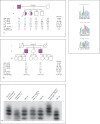A Novel Mutation in the TBG Gene Producing Partial Thyroxine-Binding Globulin Deficiency (Glencoe) Identified in 2 Families
- PMID: 28785540
- PMCID: PMC5527229
- DOI: 10.1159/000455097
A Novel Mutation in the TBG Gene Producing Partial Thyroxine-Binding Globulin Deficiency (Glencoe) Identified in 2 Families
Abstract
Background: Thyroxine-binding globulin (TBG) is the major thyroid hormone transport protein in serum. Located on the long arm of the X chromosome, TBG (SERPINA7) gene mutations most commonly produce inherited partial TBG deficiency (TBG-PD).
Objective: We report a novel TBG variant associated with TBG-PD identified in 2 different families of Ashkenazi origin residing in greater Chicago.
Methods: Family 1: The proband was 12.6 years old when she presented for delayed puberty and was placed on L-T4. Although her serum TSH normalized, her serum T4 remained low. Affected family members had low total T4 and T3, but a normal free T4 index, even when serum TSH concentrations were normal. Family 2: A 71-year-old male presented with a history of a nonfunctioning pituitary adenoma and normal pituitary axes except for low total T4 and T3. His brother had a similar thyroid phenotype.
Results: Following direct DNA sequencing, both index patients were found to carry a missense mutation in the TBG gene (c.751T>G) producing p.V215G. The proposita of family 1 was heterozygous and the proband in family 2 was hemizygous for the mutation. Isoelectric focusing showed no alteration in the TBG isoforms and in vitro expression demonstrated a TBG with reduced affinity for T4.
Conclusions: We report a novel mutation in the TBG gene in 2 unrelated families that produces a molecule with reduced affinity for T4 resulting in low serum T4. However, the physical properties of the mutant molecule remained unaltered as determined by isoelectric focusing.
Keywords: Mutation; T4-binding affinity; Thyroxine-binding globulin; Thyroxine-binding globulin deficiency.
Figures

Similar articles
-
Partial Thyroid Hormone-Binding Globulin Deficiency: A Case Report and Literature Review.Diabetes Metab Syndr Obes. 2023 Jul 26;16:2225-2232. doi: 10.2147/DMSO.S413048. eCollection 2023. Diabetes Metab Syndr Obes. 2023. PMID: 37525823 Free PMC article.
-
Partial thyroxine-binding globulin deficiency in a family with coding region mutations in the TBG gene.J Endocrinol Invest. 2020 Dec;43(12):1703-1710. doi: 10.1007/s40618-020-01245-1. Epub 2020 Apr 7. J Endocrinol Invest. 2020. PMID: 32266677
-
Thyroxine-binding globulin deficiency due to a novel SERPINA7 mutation: Clinical characterization, analysis of X-chromosome inactivation pattern and protein structural modeling.Gene. 2018 Aug 5;666:58-63. doi: 10.1016/j.gene.2018.05.018. Epub 2018 May 4. Gene. 2018. PMID: 29733970
-
[Partial thyroxine binding globulin deficiency in test tube infants: report of cases and literature review].Zhonghua Er Ke Za Zhi. 2016 Jun 2;54(6):428-32. doi: 10.3760/cma.j.issn.0578-1310.2016.06.008. Zhonghua Er Ke Za Zhi. 2016. PMID: 27256229 Review. Chinese.
-
TBG deficiency: description of two novel mutations associated with complete TBG deficiency and review of the literature.J Mol Med (Berl). 2006 Oct;84(10):864-71. doi: 10.1007/s00109-006-0078-9. Epub 2006 Sep 1. J Mol Med (Berl). 2006. PMID: 16947003 Review.
Cited by
-
Insights Into Central Congenital Hypothyroidism: A Multicenter Retrospective Analysis.J Clin Endocrinol Metab. 2025 Apr 22;110(5):e1653-e1659. doi: 10.1210/clinem/dgae485. J Clin Endocrinol Metab. 2025. PMID: 39008607 Free PMC article.
-
Identification of Mutations in the Thyroxine-Binding Globulin (TBG) Gene in Patients with TBG Deficiency in Korea.Endocrinol Metab (Seoul). 2022 Dec;37(6):870-878. doi: 10.3803/EnM.2022.1591. Epub 2022 Dec 7. Endocrinol Metab (Seoul). 2022. PMID: 36475360 Free PMC article.
-
A thyroid adenoma in a pubertal male with thyroxine-binding globulin deficiency.Clin Pediatr Endocrinol. 2024;33(1):23-26. doi: 10.1297/cpe.2023-0031. Epub 2023 Nov 12. Clin Pediatr Endocrinol. 2024. PMID: 38299172 Free PMC article.
-
Novel frameshift mutation causes early termination of the thyroxine-binding globulin protein and complete thyroxine-binding globulin deficiency in a Chinese family: A case report.World J Clin Cases. 2019 Nov 26;7(22):3887-3894. doi: 10.12998/wjcc.v7.i22.3887. World J Clin Cases. 2019. PMID: 31799319 Free PMC article.
-
Partial Thyroid Hormone-Binding Globulin Deficiency: A Case Report and Literature Review.Diabetes Metab Syndr Obes. 2023 Jul 26;16:2225-2232. doi: 10.2147/DMSO.S413048. eCollection 2023. Diabetes Metab Syndr Obes. 2023. PMID: 37525823 Free PMC article.
References
-
- Bartalena L. Recent achievements in studies on thyroid hormone-binding proteins. Endocr Rev. 1990;11:47–64. - PubMed
-
- Hayashi Y, Mori Y, Janssen OE, Sunthornthepvarakul T, Weiss RE, Takeda K, Weinberg M, Seo H, Bell GI, Refetoff S. Human thyroxine-binding globulin gene: complete sequence and transcriptional regulation. Mol Endocrinol. 1993;7:1049–1060. - PubMed
-
- Mannavola D, Vannucchi G, Fugazzola L, Cirello V, Campi I, Radetti G, Persani L, Refetoff S, Beck-Peccoz P. TBG deficiency: description of two novel mutations associated with complete TBG deficiency and review of the literature. J Mol Med (Berlin) 2006;84:864–871. - PubMed
Grants and funding
LinkOut - more resources
Full Text Sources
Other Literature Sources
Miscellaneous

